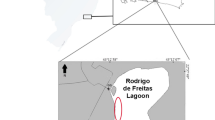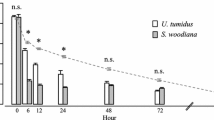Abstract
Biomanipulation of filter-feeding bivalves or fish can serve as complementary measures to zooplankton manipulation approach in lakes dominated by large-sized algae. A laboratory grazing experiment was conducted to compare the selective grazing of benthic bivalves (Hyriopsis cumingii) and planktivorous fish (silver carp) on particle size and algae species. Their combination grazing effects were also detected. The results showed that the clearance rates of silver carp were higher than that of H. cumingii, and that silver carp preferred particles in the 30–50 and 50–100 μm size fraction whereas H. cumingii did not show a significant selective grazing on seston size. Furthermore, the differences between the selective grazing of H. cumingii and silver carp on algae species were detected. Some algae species, which had not been digested well by silver carp, were not detected in H. cumingii’s pseudofeces. Similarly, some algal species in the pseudofeces of bivalves were not detected in the feces of fish. Moreover, the combined clearance rates of H. cumingii and silver carp (ranging from 12.14 to 95.99 mL g DW−1 h−1) were higher than that of single filter feeder (0.47 to 10.18 mL g DW−1 h−1). We suggest therefore that when using biomanipulation measures to control large-sized algal overgrowth, a combination of different filter feeders may be a better way considering their collaborative grazing in both particle size and algae species selectivity.


Similar content being viewed by others
References
Alvarez E, Lopez-Urrutia A, Nogueira E, Fraga S (2011) How to effectively sample the plankton size spectrum? A case study using FlowCAM. J Plankton Res 33:1119–1133
Borcherding J (1992) Another early warning system for the detection of toxic discharges in the aquatic environment based on valve movements of the freshwater mussel Dreissena polymorpha. In: Neumann D, Jenner HA (eds) The zebra mussel Dreissena polymorpha: ecology, biological monitoring and first applications in water quality management. Gustav Fischer Verlag, Stuttgart, pp 127–146
Bunt CM, MacIsaac HJ, Sprules WG (1993) Pumping rates and projected filtering impacts of juvenile zebra mussels (Dreissena polymorpha) in western Lake Erie. Can J Fish Aquat Sci 50:1017–1022
Burns CW (1968) The relationship between body size of filter-feeding Cladocera and the maximum size of particle ingested. Limnol Oceanogr 13(4):675–678
Cai YJ, Gong ZJ, Qin BQ (2010) Community structure and diversity of macrozoobenthos in Lake Taihu, a large shallow eutrophic lake in China. Biodivers Sci 18:50–59
Cooke GD, Welch EB, Peterson SA, Nicholas SA (2005) Restoration and management of lakes and reservoirs. CRC Press, Boca Raton
Coughlan J (1969) The estimation of filtering rate from the clearance of suspensions. Mar Biol 2:356–358
Dame R F, Olenin S (2005) The comparative roles of suspension-feeders in ecosystems: proceedings of the NATO Advanced Research Workshop on The Comparative Roles of Suspension-Feeders in Ecosystems, Nida, Lithuania, 4-9 October 2003 (Vol. 47). Springer Science & Business Media
Dolmer P (2000) Feeding activity of mussels Mytilus edulis related to near-bed currents and phytoplankton biomass. J Sea Res 44(3):221–231
Fei ZL, Wu J, Zhao Q, Tang JQ, Huang C (2006) Effect of filtration and digestion of Hyriopsis cumingii to algae. Freshw Fish 36(5):24–27
Gulati RD, Pires LMD, Van Donk E (2008) Lake restoration studies: failures, bottlenecks and prospects of new ecotechnological measures. Limnologica 38:233–247
Guo L, Wang Q, Xie P, Tao M, Zhang J, Niu Y, Ma Z (2015) A non-classical biomanipulation experiment in Gonghu Bay of Lake Taihu: control of Microcystis blooms using silver and bighead carp. Aquac Res 46:2211–2224
He H, Liu X, Liu X, Yu J, Li K, Guan B, Liu Z (2014) Effects of cyanobacterial blooms on submerged macrophytes alleviated by the native Chinese bivalve Hyriopsis cumingii: a mesocosm experiment study. Ecol Eng 71:363–367
Jeppesen E, Søndergaard M, Lauridsen TL, Davidson TA, Liu Z, Mazzeo N, Meerhoff M (2012) Biomanipulation as a restoration tool to combat eutrophication: recent advances and future challenges. Adv Ecol Res 47:411–487
Karatayev AY, Burlakova LE, Padilla DK (1997) The effects of Dreissena polymorpha (Pallas) invasion on aquatic communities in eastern Europe. J Shellfish Res 16:187–203
Knoll LB, Sarnelle O, Hamilton SK, Kissman CE, Wilson AE, Rose JB, Morgan MR (2008) Invasive zebra mussels (Dreissena polymorpha) increase cyanobacterial toxin concentrations in low-nutrient lakes. Can J Fish Aquat Sci 65(3):448–455
Kotta J, Orav-Kotta H, Vuorinen I (2005) Field measurements on the variability in biodeposition and estimates of grazing pressure of suspension-feeding bivalves in the northern Baltic Sea. In: Dame RF, Olenin S (eds) The comparative roles of suspension-feeders in ecosystems. NATO Science Series IV: Earth and Environmental Series, 47. Springer, Dordrecht
Liu JK, Xie P (1999) Unraveling the enigma of the disappearance of water bloom from the East Lake (Lake Donghu) of Wuhan. Resour Environ Yangtze Basin 8(3):312–319
Liu J, Xie P (2003) Direct control of microcystis bloom through the use of planktivorous carp–closure experiments and lake fishery practice. Ecol Sci 22(3):193–196
Liu QG, Chen MK, Tong HY, He GX, Hong RH, Chen LS, Chen LQ (2004) Study on the possible cause of water blooming and the bloom-prevention technology in Lake Qiandaohu. Agric Sci China 3:627–633
Ma H, Cui F, Liu Z, Fan Z, He W, Yin P (2010) Effect of filter-feeding fish silver carp on phytoplankton species and size distribution in surface water: a field study in water works. J Environ Sci 22(2):161–167
Milstein A, Ahmed AF, Masud OA, Kair A, Wahab MA (2006) Effects of the filter feeder silver carp and the bottom feeders mrigal and common carp on small indigenous fish species (SIS) and pond ecology. Aquaculture 258:439–458
Miura T (1990) The effects of planktivorous fishes on the plankton community in a eutrophic lake. Hydrobiologia 200(1):567–579
Naddafi R, Pettersson K, Eklöv P (2007) The effect of seasonal variation in selective feeding by zebra mussels (Dreissena polymorpha) on phytoplankton community composition. Freshw Biol 52(5):823–842
Newell CR, Wildish DJ, MacDonald BA (2001) The effects of velocity and seston concentration on the exhalant siphon area, valve gape and filtration rate of the mussel Mytilus edulis. J Exp Mar Biol Ecol 262(1):91–111
Nizzoli D, Welsh DT, Bartoli M, Viaroli P (2005) Impacts of mussel (Mytilus galloprovincialis) farming on oxygen consumption and nutrient recycling in a eutrophic coastal lagoon. Hydrobiologia 550(1):183–198
Oganjan K, Lauringson V (2014) Grazing rate of zebra mussel in a shallow eutrophicated bay of the Baltic Sea. Mar Environ Res 102:43–50
Palmer MA, Ambrose RF, Poff NL (1997) Ecological theory and community restoration ecology. Restor Ecol 5(4):291–300
Rinta-Kanto JM, Saxton MA, DeBruyn JM, Smith JL, Marvin CH, Krieger KA, Sayler GS, Boyer GL, Wilhelm SW (2009) The diversity and distribution of toxigenic Microcystis spp. in present day and archived pelagic and sediment samples from Lake Erie. Harmful Algae 8(3):385–394
Søndergaard M, Jensen JP, Jeppesen E (2003) Role of sediment and internal loading of phosphorus in shallow lakes. Hydrobiologia 506(1):135–145
Søndergaard M, Jeppesen E, Lauridsen TL, Skov C, Van Nes EH, Roijackers R, Lammens E, Portielje ROB (2007) Lake restoration: successes, failures and long-term effects. J Appl Ecol 44(6):1095–1105
Vanderploeg HA, Liebig JR, Carmichael WW, Agy MA, Johengen TH, Fahnenstiel GL, Nalepa TF (2001) Zebra mussel (Dreissena polymorpha) selective filtration promoted toxic microcystis blooms in Saginaw Bay (Lake Huron) and Lake Erie. Can J Fish Aquat Sci 58(6):1208–1221
Vaughn CC, Gido KB, Spooner DE (2004) Ecosystem processes performed by unionid mussels in stream mesocosms: species roles and effects of abundance. Hydrobiologia 527(1):35–47
Vörös L, Oldal I, Présing M et al. (1997) Size–selective filtration and taxon–specific digestion of plankton algae by silver carp (Hypophthalmichthys molitrix Val.). Springer Netherlands, pp 223–228
Wang J, Xie P, Takamura N, Xie LQ, Shao ZJ, Tang HJ (2004) The picophytoplankton in three Chinese lakes of different trophic status and its relationship to fish populations. J Freshw Ecol 19:285–293
Wang C, Wu X, Tian C, Li Q, Tian Y, Feng B, Xiao B (2015) A quantitative protocol for rapid analysis of cell density and size distribution of pelagic and benthic Microcystis colonies by FlowCAM. J Appl Phycol 27(2):711–720
Wang L, He F, Sun J, Hu Y, Huang T, Zhang Y, Wu Z (2017) Effects of three biological control approaches and their combination on the restoration of eutrophicated waterbodies. Limnology 18(3):301–313
Ward JE, Shumway SE (2004) Separating the grain from the chaff: particle selection in suspension-and deposit-feeding bivalves. J Exp Mar Biol Ecol 300(1):83–130
Xie P (2003) Silver carp and bighead, and their use in the control of algal blooms, 1st edn. Science Press, Beijing
Xie P, Liu J (2001) Practical success of biomanipulation using filter-feeding fish to control cyanobacteria blooms: a synthesis of decades of research and application in a subtropical hypereutrophic lake. Sci World J 1:337–356
Xu GC, Hua D, Gu RB, Wen HB, Shao XP, Kong LL (2008) Distribution properties of digestive enzyme of Hyriopsis cumingii and morphological configuration of crystalline style. J Fish China 32(2):296–300
Zhang X, Xie P, Huang X (2008) A review of nontraditional biomanipulation. Sci World J 8:1184–1196
Zhang X, Liu Z, Jeppesen E, Taylor WD (2014) Effects of deposit-feeding tubificid worms and filter-feeding bivalves on benthic-pelagic coupling: implications for the restoration of eutrophic shallow lakes. Water Res 50:135–146
Zhao SY, Sun YP, Lin QQ, Han BP (2013) Effects of silver carp Hypophthalmichthys molitrix and nutrients on the plankton community of a deep tropical reservoir. An enclosure experiment. Freshw Biol 58:100–113
Zhu SB, Wang Y, Wang XD, Wang WL, Dong XQ (2008) Plankton community and primary productivity in waters for culturing freshwater pearl mussel (Hyriopsis cumingii) under different stockings and management models. Chin J Ecol 27(3):401–407
Acknowledgments
This study was supported by grants from the National Science and Technology Support Program of the 12th Five-Year Plan, China (No. 2012BAJ21B03–004), National Natural Science Foundation of China (51178452), Major Science and Technology Program for Water Pollution Control and Treatment of China 12th Five-Year Plan (No. 2012ZX07101007–005), and Hubei Province Science Foundation for Youths (2014CFB282). The authors thank Drs. Lin Ma, Biyun Liu, Enrong Xiao, Dong Xu, and Junmei Wu, and Ms. Liping Zhang for the experimental help (Institute of Hydrobiology, Chinese Academy of Sciences).
Author information
Authors and Affiliations
Corresponding author
Additional information
Responsible editor: Philippe Garrigues
Rights and permissions
About this article
Cite this article
Wang, L., Liu, P., Sun, J. et al. Comparison and combination of selective grazing on natural seston by benthic bivalves (Hyriopsis cumingii) and pelagic fish (Hypophthalmichthys molitrix). Environ Sci Pollut Res 25, 33423–33431 (2018). https://doi.org/10.1007/s11356-018-3287-1
Received:
Accepted:
Published:
Issue Date:
DOI: https://doi.org/10.1007/s11356-018-3287-1




